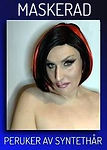
2nd HAND WIG SHOP
Find Your Next Wig in Our Second-Hand Collection
Welcome to our pre-loved wig and hairpiece shop, where you can find your next wig at a great price! We offer wigs in all categories — both new and second-hand, all in excellent condition.
Do you have a wig you no longer use? You can sell it through us and give it a second life.
What type of wig are you looking for?


Follow us on FB
Cosplay Wigs
Custom Made
Or are you looking for...
Wig Care
Rent a Wig
Trade y our Wig
Education
Products
WIG CARE A-B-C
Keep Your Wig Looking Great for Longer
A wig can last a long time and look fantastic — if you take proper care of it.
Here, we've gathered some essential tips on how to care for your wig in the best possible way.
The care instructions will depend on what your wig is made of.
HUMAN HAIR & HUMAN HAIR BLEND
These wigs are made from real human hair.
A human hair blend wig combines both real and synthetic fibers, and these can be more challenging to care for, since the materials behave differently.
Human hair wigs can generally be treated like natural hair — including washing, heat styling, and conditioning — with appropriate products and care.
SYNTHETIC FIBERS
Most wigs on the market are made from synthetic materials, which vary widely in quality.
We divide synthetic wigs into three main categories:
-
Lace Front Wigs
-
Hard Front Wigs
-
Costume/Masquerade Wigs
All synthetic wigs require a different care routine than human hair wigs. For example:
-
Do not use regular shampoo or conditioner.
-
They are best refreshed with steam rather than traditional washing.
-
They are sensitive to styling products — use them sparingly.
You may come across different fiber names, such as Kanekalon, Toyokalon, Kanubia, or Japanese fibers.
Some brands use proprietary names for their fiber blends, but most synthetic wigs are based on Kanekalon as the standard.
WASHING
A wig should be washed when it’s visibly dirty or starts to smell less than fresh.
However, overwashing can shorten its lifespan, so it’s important to find a balance.
The general recommendation is to wash a wig after a maximum of 20 uses, assuming no styling products have been applied.
In reality, most wigs need washing more frequently.
Wearing a wig for a full day causes the scalp to sweat between 200–500 ml, which accumulates in the wig.
Not washing your wig regularly can lead to:
-
An unpleasant odor
-
Stiff, unnatural hair texture
-
A buildup of bacteria
-
Shortened fiber life
If you use styling products, it’s even more important to wash them out regularly.
Storing a wig with product residue can damage the fibers over time, causing them to break and making the wig look worn out.

For Human Hair Wigs and Human Hair Blends
Use high-quality shampoo and conditioner — don’t compromise on quality. The better the products are for your natural hair, the better they are for your wig. Occasionally, you can apply a hair mask, but do so carefully — rich, oily masks can make the wig heavy and greasy. Choose a light, non-oily treatment.
For Synthetic Wigs
Use special wig shampoo and conditioner designed for synthetic fibers. These can be expensive, but there are effective, low-cost alternatives:
-
Shampoo substitute: Liquid color laundry detergent or a few tablespoons of baking soda
-
Conditioner substitute: Fabric softener works perfectly
Do not use regular hair products on synthetic wigs — they can leave a dull, sticky residue.
Removing Adhesive Residue
If your wig has leftover glue, remove it before washing. Use isopropyl alcohol to dissolve Mastix glue, but apply with caution — it can dry out fibers. Work quickly and gently. An old toothbrush can help remove residue, but brush only on the inside of the wig.
If you prefer a gentler method, try massaging conditioner into the area — it can often loosen the glue.
Once the glue is removed, proceed immediately with the washing process.
General Washing Instructions (All Wig Types)
Never wash your wig under running water — instead, use a bowl or basin, which is much gentler on the hair.
-
For human hair: Use lukewarm water
-
For synthetic hair: Use cool to cold water (max 27°C)
-
Fill the bowl with water and dissolve your chosen shampoo or baking soda.
-
Place the wig in the water and let it soak (especially for synthetics).
-
Gently lift the wig up and down in the water to loosen dirt.
-
Let it soak for a few more minutes, then repeat the lifting motion before removing it from the bowl. Rinse the wig in a new bowl of clean water (cold for synthetic, lukewarm for human hair).
-
Synthetic wigs: Prepare another bowl with ice-cold water and fabric softener
-
Human hair: Apply conditioner directly to the hair and rinse after 10 minutes. Let synthetic wigs sit in the softener solution for up to 30 minutes, then rinse 1–2 more times in clean cold water using the same lifting motion.
Drying the Wig
Place the wig on a wig stand or drip-dry rack and let it air dry completely before touching or styling it. This can take a full day.
To speed up drying, you can use a vented wig dryer head that circulates air gently from below without damaging the fibers.
Tip: Place the stand in a bathtub or shower to avoid water damage to your floors while it drips dry
BRUSHING AND COMBING
Wigs should always be combed or brushed starting from the ends — the opposite of how most people brush their natural hair. Begin by gently detangling the tips, then work your way up toward the roots.
While the brushing motion should still follow the natural direction of the hair, starting from the roots can damage the wig. Brushing from the base pulls on knots and strands, which can lead to excessive shedding and leave the wig looking thin over time.
To avoid this:
-
Brush in small sections
-
Always begin at the ends
-
Work slowly and gently
-
Never force the hair to detangle — be patient and kind to the fibers
Choose the Right Brush
Regular hairbrushes can sometimes be too harsh for wigs. They may pull and stretch the fibers instead of gently detangling them. For best results, use a wig-specific brush or a wide-tooth comb designed to protect the wig’s structure and prevent damage.

For best results, always use a brush or comb specifically designed for wigs or hair extensions. These are available at low cost — for example, in our webshop. There are different types of brushes for human hair and synthetic hair. For curly wigs, finger-combing is often enough to maintain the shape without causing frizz or damage.
Use a Wig Stand for Styling
If you have a wig stand, use it when working on your wig. Secure the wig with wig pins to make brushing and styling easier and more precise. Short wigs can also be brushed directly while wearing them on the head.
Use Detangling Spray Wisely
A detangling spray can help your brush glide through the hair more easily and often contains nourishing ingredients.
However, make sure to use a spray that matches your wig type:
-
Human hair spray for human hair wigs
-
Synthetic spray for synthetic wigs
Avoid using the wrong type — and don’t overapply. Too much product can make the wig heavy or greasy-looking.
Regular Brushing Matters
Regardless of how often you wear your wig, it’s important to brush it regularly to keep it in great condition.
Gentle, consistent care will extend the life and beauty of your wig.
STYLING & STEAMING
Heat styling always causes some wear on hair — whether it's natural or synthetic.
Human hair wigs can handle heat styling without immediate damage (though it may affect them over time), but synthetic wigs often cannot.
If your wig is heat-resistant, it will usually say so in the product instructions.
However, if you've purchased a second-hand wig, this information may be missing.
In such cases, test a small, hidden section (like at the nape of the neck) with a low heat setting before styling the entire wig.
Blow-Drying is Generally Not Recommended
In general, it’s not recommended to blow-dry wigs at all.
-
Human hair wigs can be blow-dried, but it’s crucial to use a heat-protectant spray to avoid drying out or damaging the hair.
-
Even with real hair, improper heat styling can make the wig dull, dry, or brittle over time.

Wigs Don’t Get Nutrients from the Scalp
Unlike natural hair, wigs don’t receive moisture or nutrients from the scalp. This makes them more vulnerable to damage, especially from heat styling. Do not blow-dry synthetic wigs at all.
Heat Styling – Be Cautious
-
Curling irons and flat irons can be used on human hair wigs, but only certain synthetic wigs can tolerate heat.
-
Synthetic fibers cannot handle the same high temperatures as real hair.
-
If you want to curl your wig, heated rollers are a much gentler alternative than curling wands or straighteners.
Regardless of hair type, always be minimal with heat-based styling to preserve your wig's lifespan.
Steaming – The Best Way to Style Synthetic Wigs
Steaming is by far the best and safest method to refresh and style synthetic wigs.
Do not steam human hair wigs — this method is strictly for synthetic fibers.
After washing and drying your wig completely, you can brush it while applying steam.
Steam smooths and revives the fibers, making the wig look refreshed and almost like new.
You can purchase special wig steamers for this purpose.
What Can You Use to Steam?
-
A classic kettle with a spout
-
A garment steamer
-
A wig steamer with a brush attachment (like the one available in our webshop – perfect for long wigs)
⚠️ Never use a steam iron!
Steam irons have a hot plate, and even a brief touch can permanently damage your wig. Always double-check that you're using a proper steamer, not an iron.
Curling Synthetic Wigs with Steam
-
Roll sections of the wig using rollers or curlers.
-
Apply steam generously over the entire wig.
-
Let the wig air-dry for several hours.
-
Once dry, remove the curlers and gently brush the wig (without steam).
Steaming human hair or blends requires advanced knowledge.
Also, never use steam on wigs that are not labeled as heat-resistant.
If you’re unsure whether your wig can handle heat, test a small, hidden section (like the nape) first.
PRODUCT CHART
Even though they’re sometimes necessary, wigs don’t "like" styling products.
To protect your wig, always minimize the amount used — and be sure to wash out all products if the wig will be stored before its next use.
Leaving product residue can cause more damage over time than frequent wear.
Styling Human Hair Wigs
For human hair wigs, you can use regular styling products, just as you would on natural hair. However, always follow good styling practices and avoid overloading the hair.
Styling Synthetic Hair Wigs
Synthetic wigs require more care. To reduce wear and tear, follow these key guidelines:
-
Hairspray is the most commonly used product, but not all sprays are safe.
-
Use a spray made specifically for wigs, or at the very least, ensure it's completely water-soluble.
-
The best choice is a hairspray formulated for synthetic fibers, as it won’t leave buildup or dry out the strands.
Choosing the right spray will significantly extend the lifespan of your wig.

Be Careful with Styling Products on Synthetic Wigs
The chemicals in regular hairsprays can break down synthetic fibers over time. Brands like Jon Renau, Revlon, and Wella offer special sprays formulated for synthetic wigs — you can easily find these online.
What About Other Styling Products?
Synthetic hair can sometimes tolerate mousse or gel, but results vary by wig type. Wax should never be used on synthetic wigs.
Regardless of the product type, always follow this golden rule:
✅ Only use water-soluble products
And even then — use as little as possible. The less product, the better for the longevity and natural look of your wig.
Styling Affects Movement and Realism
Keep in mind: the more styling product you use, the stiffer and less natural the hair will look.
If your wig doesn’t move — even in the wind — it’s a clear sign it’s been over-styled.
STORAGE & TRAVEL
Wigs should be stored away from direct sunlight, heat, and dust.
It’s also smart to keep them out of reach of pets and curious children.
Traveling with Wigs
You can find dedicated wig travel cases online — they’re fun and stylish, but for most people, they’re more of a luxury than a necessity.For home storage, we recommend using wig bags, similar to garment bags. They’re affordable, practical, and fit up to two wigs, making them easy to hang in a closet.
Simple At-Home Storage Tips
If you’re storing your wig for more than a day:
-
Fold it ear-to-ear (works best for short to medium-length wigs)
-
For very short or unstyled wigs, you can turn them inside out
-
For long, straight wigs, loosely braid the ends in sections to prevent tangling during storage
-
Cover the wig with a hairnet, especially if it’s synthetic — this helps maintain shape and protect the fibers

If a heat-sensitive synthetic wig loses its style, it will be very difficult to restyle.
To protect it, place the wig in a plastic container or sealable plastic bag — this helps prevent the fibers from drying out during storage.
CUTTING & ADVANCED CARE
Of course, it’s great to be able to take care of your wig on your own.
But when it comes to cutting or more advanced care, it's best not to attempt it unless you truly know what you’re doing.
That leaves you with two great options:
-
You can send your wig to us for a full "renovation."
Sweden’s top wig experts will restore and refresh your wig with professional care. -
Or you can take our WIGMASTER I course, where you'll learn everything you’ve ever wanted to know about wigs and how to properly care for them (see next section).
And remember — we’re always here to help.
Feel free to contact us if you need assistance with anything related to your wig.

WIGMASTER SERIE 1-3
WIGMASTER is our unique training series — the only program of its kind in all of Scandinavia.
The Wigmaster education is divided into three levels, each building on the last.
-
The first level is open to anyone who owns or uses a wig.
-
The second level is for those seriously interested in the art of wig styling and care.
-
The final level is the most advanced wig course in Scandinavia and provides professional-level skills in wig making and handling.
After completing the full program, you will be qualified to work with wigs in settings such as theatre, film, and television.
WIGMASTER 1 – JUNIOR WIGMASTER
A foundational course designed to give you a full understanding of how to properly care for and handle wigs.
The knowledge gained in this course is essential for progressing to the higher levels and provides a solid base for any wig owner.
📅 Contact us for upcoming course dates and more information.
.jpg)
WIGMASTER 2 – EXPERT WIGMASTER
📆 Held in September
This course focuses on repairing damaged wigs, reviving old and worn pieces, and the art of modernizing outdated styles.
You’ll learn how to transform straight hair to curly (and vice versa), create new hairstyles, and breathe new life into wigs that were once considered unusable.
📅 Contact us for course dates and more information.
WIGMASTER 3 – PRO WIGMASTER
📆 Held in November
This advanced course teaches you how to create your own lace front wig from a standard wig base — fully customized to your own design.
You’ll explore multiple techniques to achieve a flawless, professional finish.
This is a high-level course with extensive personal coaching, offering participants near-professional skills in wig craftsmanship.
Graduates of Wigmaster 3 are prepared to work with wigs in theatre, retail, film, and other professional environments.
WIGMASTER 3 PRO+
As an exclusive upgrade, participants of Wigmaster 3 are offered eight private coaching sessions with renowned wig expert Alexandra Södergren.
These one-on-one lessons are fully customizable, focusing on the specific areas each student wants to deepen their knowledge in.
📅 Contact us for course dates and more information.


.jpg)
.jpg)
.jpg)
.jpg)

.jpg)





.jpg)

